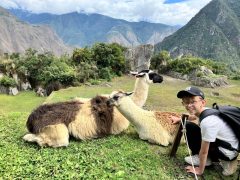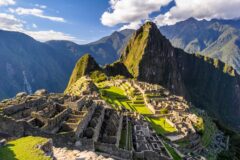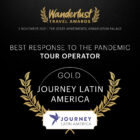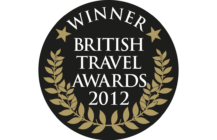Private Journeys
Luxury Peru and Galapagos: Machu Picchu and the Enchanted Islands
14 days from £10,160pp
(based on two people sharing & excluding flights)
Essentials
-
Tour info
-
Country info
-
What's included
Tour info
Transport
5 flights (longest 2.5hrs); 2 rail and road journeys (longest 4hrs).
Accommodation
This holiday incorporates first class luxury boutique hotels with plenty of history and special features. They have excellent locations and top-of-the range facilities. Ocean Spray is a small and intimate first class motor catamaran offering ocean-borne luxury, excellent service and well guided excursions
Meals
Breakfast daily, lunch days 3, 5; dinner day 4; full board days 9-13.
Guides
We carefully select our local partners, some of whom we have worked with for over 25 years. Their English-speaking guides understand the expectations of our clients very well, and are consistently singled out for praise by the latter on their return.
Summary Of Nights
14 days, 13 nights: Lima 1; Urubamba 2; Machu Picchu 1; Cusco 2; Quito 2; Galápagos 5.
Currency
The unit of currency in Peru is the sol.
How To Take It
Cash machines are available in all major cities and towns, and so taking a debit or credit card with a PIN number is the most convenient way of withdrawing money while on your trip, and in most shops and restaurants you can also pay by card. However, since cards can get lost, damaged, withheld or blocked, you should not rely exclusively on a card to access funds.
We recommend that additionally you take a reasonable quantity of US dollars cash (no more than is covered by your insurance), which you can exchange into local currency, and possibly some travellers’ cheques (American Express are the most widely accepted), though these are gradually falling out of use. Dollar bills should be in good condition, soiled or torn bills may be refused. You can take sterling, but the exchange rate is not always competitive or even available, restricting the number of places where you can change money.
Daily Spend
It is very difficult to give a guideline for essential expenses but a budget of around US$50 per day should cover the cost drinks and the odd souvenir, and of good quality meals on those days in the holiday itinerary when not on the cruise.. Eat at the very best restaurants and you will pay considerably more.
Tipping
Tips are expected and local guides often rely on their tip as a significant proportion of their income.
Most service industry workers will expect a tip of some kind and so it is useful to have spare change for hotel porters, taxi drivers and the like. It is common to leave 10 – 12% in restaurants.
Tipping guidelines can be found in our Briefing Dossier.
Insurance
Travel insurance is essential. Details of our recommended policy can be found on our Travel Insurance page.
Given the limited medical facilities in the Galápagos Islands and the costs related to air ambulance services, you are strongly encouraged to obtain travel insurance which includes air ambulance services.
Airport Taxes
If you have purchased your flights through Journey Latin America, the international departure tax is usually included in the ticket.
Visas
Holders of a full British passport do not require a visa, although passports must be valid for at least 6 months after the trip begins. Anyone with a different nationality should enquire with us or check with the relevant consulate.
If flying to the US, or via the US you will need to fill in your online ESTA application.
Trip Suitability
This holiday is suitable for all able, reasonably fit visitors. The sea can be choppy around the Galápagos islands. The streets in Cusco are cobbled and steep.
Climate
The rainy season in the Andes runs between November and March when there are showers most afternoons. The dry season is in June, July and August when the sun is strong during the day, but at night the temperature drops dramatically (from freezing point to 10°C). May, September and October are less predictable, with both rainy and sunny spells.
Lima is covered in a dull grey mist for much of the year, although the sun does break through between November and March. It almost never rains in Lima, and temperatures are moderate.
In Cusco and the highlands, June to September can be very cold at night, but days are usually extremely clear with sun. November to April are the wettest months of the year – note that rains tend to be in short, heavy bursts, rather than continual showers, with rains clearing towards the end of April. Nights are cold throughout the year at altitude.
In the Galápagos, from January to April it’s hot and the sun is relentless, with some sudden showers. May to July, and October to December is cloudier; August and September it’s often cloudy and cool, and a stiff breeze makes the waters choppier. High and Low seasons reflect demand rather than the best time to go. Many boats are in dry dock in September.
Altitude
Your stay in Cusco and the Sacred Valley is at high altitude (2,800-3,300m). A small minority of visitors may suffer temporarily from altitude sickness. Symptoms vary; most common are mild headaches, slight nausea and breathlessness. If you don’t recover in a day or two speak to our representatives; in very rare instances it is necessary to descend to lower altitudes. Most people are unaffected and if you drink plenty of water and allow your body to acclimatise (don’t exert yourself or drink alcohol) in the first couple of days after arrival, you will minimise your chances of suffering any symptoms.
Please refer to our Briefing Dossier for further information.
Clothing And Special Equipment
For day-to-day wear you should go prepared to encounter all seasons. Both warm clothing and a sun hat are essential at altitude; a light fleece jacket and a waterproof/breathable outer shell makes a good combination. Trousers, skirt or shorts made from light, quick-drying synthetic materials work well. If you plan to eat in smart restaurants, although clothing is not formal (no need for jacket and tie), something quite smart would be appropriate.
Strong, comfortable footwear is essential and you should bring insect repellant, sun block, hat and sun glasses. You should take swimwear for pools and ocean swimming (Galápagos). The ship provides complimentary use of snorkelling equipment and 3mm ‘shorty’ wetsuits but you may prefer to bring your own. Aqua-socks or rubber sandals are useful for embarking and disembarking on wet landings. Bring a light waterproof jacket in case of rain. For June to November departures, the waters can be chilly.
Due to luggage restrictions on the train to Machu Picchu, main luggage must be left in Cusco. You can take up to 10kgs per person on the train and an overnight holdall is recommended to separate your luggage for the night spent away from Cusco.
Please get in touch with the office before departure if you have any doubts. Good equipment is very important and hard to come by in South America and Galápagos.
Vaccinations
Preventative vaccinations are recommended against the following: typhoid; polio; tetanus; hepatitis A. You should consult your GP for specific requirements.
For admission to the Galápagos a yellow fever certificate is required for anyone over 1 year old coming from an area with risk of yellow fever transmission.
You can also find helpful information on the Masta Travel Health website.
Country info
When is the best time to visit Peru?
The best time to visit the Andes is April to October, the dry season but at this time it is misty and chilly in Lima. The jungle is an all-year destination, as is Arequipa and the Colca Canyon.
What is Peru's official language?
The official language spoken in Peru is Spanish.
What is Peru's official currency?
The official currency of Peru is the Peruvian Nuevo Sol. Notes in local currency or US dollars can be withdrawn from the many ATMs using a UK credit or debit card. Numerous money exchange offices exchange US dollar cash (few accept euros or sterling and the rate may be poor).
What is the time difference between Peru and the UK?
The time difference between the UK and Peru is GMT-5 hours.
Do I need a visa to travel to Peru?
Holders of a full British passport do not require a visa, although passports must be valid for at least 6 months after the trip begins. Anyone with a different nationality should enquire with us or check with the relevant consulate. If flying to the US, or via the US you will need to fill in your online ESTA application.
What vaccinations are recommended for visiting Peru?
Please check https://travelhealthpro.org.uk/ for information on health recommendations and vaccinations for the destinations you are visiting. Please note that many Latin American countries require proof of vaccination against Yellow Fever if you have recently travelled to another country where Yellow Fever is present.
Which other countries combine well with Peru?
The Galapagos Islands combine well with Peru, as there are flights from Lima connecting through Guayaquil, Ecuador.
What are the festivals, cultural and sporting events in Peru?
Semana Santa (Easter): Many places throughout the country, Mar-Apr variable. Religious processions.
Inti Raymi, Cusco (24 Jun) Theatre and re-enactments of Inca history in the ruins of Sacsayhuamán, the temple fortress overlooking Cusco.
How do I adapt to the altitude in Peru?
Peru's high Andean spine is bookended by the Pacific coast and Amazon Rainforest, with Cuzco at 3,300m. Travel to high altitude can cause mountain sickness and even if you feel fighting fit it’s important to take things easy and stay hydrated (drink plenty of water, avoiding alcohol and caffeine) as you get used to the thin, dry air. You may initially notice a headache, dizziness or breathlessness and this usually improves with acclimatisation. If you are pregnant or taking the contraceptive pill, have a medical condition such as heart or lung condition, anaemia, asthma, high blood pressure you should seek the advice of your GP before booking. We also recommend you check your travel insurance covers travel to high altitude. If you’re taking the family, remember small children may be less capable of communicating altitude-related symptoms effectively: keep an eye on them too. Rest assured we will plan your itinerary carefully, taking into account any time spent at altitude. If you have any questions or concerns about altitude please speak to your travel expert.
Further advice on travel to altitude is available on www.travelhealthpro.org.uk
When To Go
At any time of year some of the fauna species will be breeding, nesting or in some other way particularly active. The climate is not extreme and even in the wetter months the rain usually only comes in afternoon showers. Dec - May the weather is hot with warm, calm seas and more chance of showers. Jun - Nov it is cooler with morning mist and choppier, colder seas.
For more detailed information visit our When To Go section.
Language
Spanish
Currency
Ecuador uses the US dollar. The bank in Puerto Ayora may offer advances on a UK credit or debit card but you are well advised to bring US dollars cash sufficient for your needs on the islands with you.
Time Difference
GMT -6 hours.
Combines With
A land tour on the Ecuadorian mainland; the Inca archaeological sites of Peru (daily flights Quito to Lima 2hrs 20mins).
Getting There
Flight time from Quito is 2-3 hours, 1.5hrs from Guayaquil. Quito flights normally touch down in Guayaquil.
Inspired by this trip
Our exciting range of articles on Latin America explore everything from iconic destinations and lesser-known cultural gems to delicious traditional recipes. You’ll also find exclusive travel tips, first-hand client reviews and the chance to get your personal questions answered by our travel experts.
Papagaio
Your edit for Latin American inspiration
Our exciting range of articles on Latin America explore everything from iconic destinations and lesser-known cultural gems to delicious traditional recipes. You’ll also find exclusive travel tips, first-hand client reviews and the chance to get your personal questions answered by our travel experts.
View Extraordinary Inspiration







































